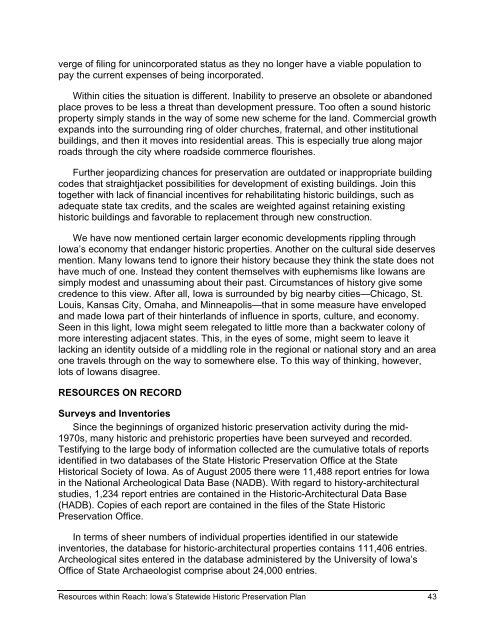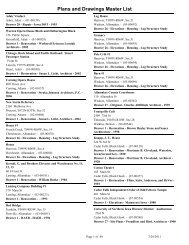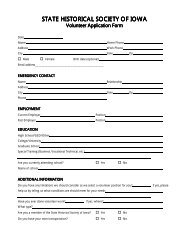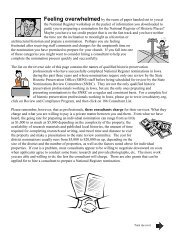Resources within Reach - State Historical Society of Iowa
Resources within Reach - State Historical Society of Iowa
Resources within Reach - State Historical Society of Iowa
- No tags were found...
You also want an ePaper? Increase the reach of your titles
YUMPU automatically turns print PDFs into web optimized ePapers that Google loves.
verge <strong>of</strong> filing for unincorporated status as they no longer have a viable population topay the current expenses <strong>of</strong> being incorporated.Within cities the situation is different. Inability to preserve an obsolete or abandonedplace proves to be less a threat than development pressure. Too <strong>of</strong>ten a sound historicproperty simply stands in the way <strong>of</strong> some new scheme for the land. Commercial growthexpands into the surrounding ring <strong>of</strong> older churches, fraternal, and other institutionalbuildings, and then it moves into residential areas. This is especially true along majorroads through the city where roadside commerce flourishes.Further jeopardizing chances for preservation are outdated or inappropriate buildingcodes that straightjacket possibilities for development <strong>of</strong> existing buildings. Join thistogether with lack <strong>of</strong> financial incentives for rehabilitating historic buildings, such asadequate state tax credits, and the scales are weighted against retaining existinghistoric buildings and favorable to replacement through new construction.We have now mentioned certain larger economic developments rippling through<strong>Iowa</strong>’s economy that endanger historic properties. Another on the cultural side deservesmention. Many <strong>Iowa</strong>ns tend to ignore their history because they think the state does nothave much <strong>of</strong> one. Instead they content themselves with euphemisms like <strong>Iowa</strong>ns aresimply modest and unassuming about their past. Circumstances <strong>of</strong> history give somecredence to this view. After all, <strong>Iowa</strong> is surrounded by big nearby cities—Chicago, St.Louis, Kansas City, Omaha, and Minneapolis—that in some measure have envelopedand made <strong>Iowa</strong> part <strong>of</strong> their hinterlands <strong>of</strong> influence in sports, culture, and economy.Seen in this light, <strong>Iowa</strong> might seem relegated to little more than a backwater colony <strong>of</strong>more interesting adjacent states. This, in the eyes <strong>of</strong> some, might seem to leave itlacking an identity outside <strong>of</strong> a middling role in the regional or national story and an areaone travels through on the way to somewhere else. To this way <strong>of</strong> thinking, however,lots <strong>of</strong> <strong>Iowa</strong>ns disagree.RESOURCES ON RECORDSurveys and InventoriesSince the beginnings <strong>of</strong> organized historic preservation activity during the mid-1970s, many historic and prehistoric properties have been surveyed and recorded.Testifying to the large body <strong>of</strong> information collected are the cumulative totals <strong>of</strong> reportsidentified in two databases <strong>of</strong> the <strong>State</strong> Historic Preservation Office at the <strong>State</strong><strong>Historical</strong> <strong>Society</strong> <strong>of</strong> <strong>Iowa</strong>. As <strong>of</strong> August 2005 there were 11,488 report entries for <strong>Iowa</strong>in the National Archeological Data Base (NADB). With regard to history-architecturalstudies, 1,234 report entries are contained in the Historic-Architectural Data Base(HADB). Copies <strong>of</strong> each report are contained in the files <strong>of</strong> the <strong>State</strong> HistoricPreservation Office.In terms <strong>of</strong> sheer numbers <strong>of</strong> individual properties identified in our statewideinventories, the database for historic-architectural properties contains 111,406 entries.Archeological sites entered in the database administered by the University <strong>of</strong> <strong>Iowa</strong>’sOffice <strong>of</strong> <strong>State</strong> Archaeologist comprise about 24,000 entries.<strong>Resources</strong> <strong>within</strong> <strong>Reach</strong>: <strong>Iowa</strong>’s <strong>State</strong>wide Historic Preservation Plan 43
















